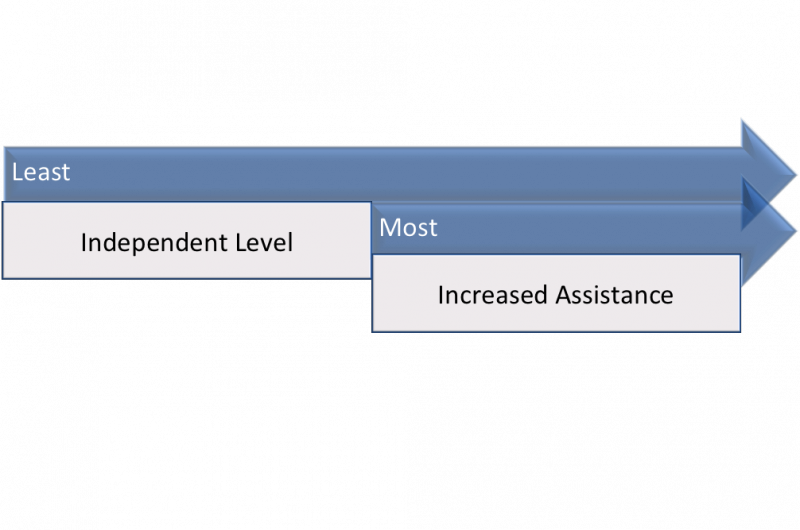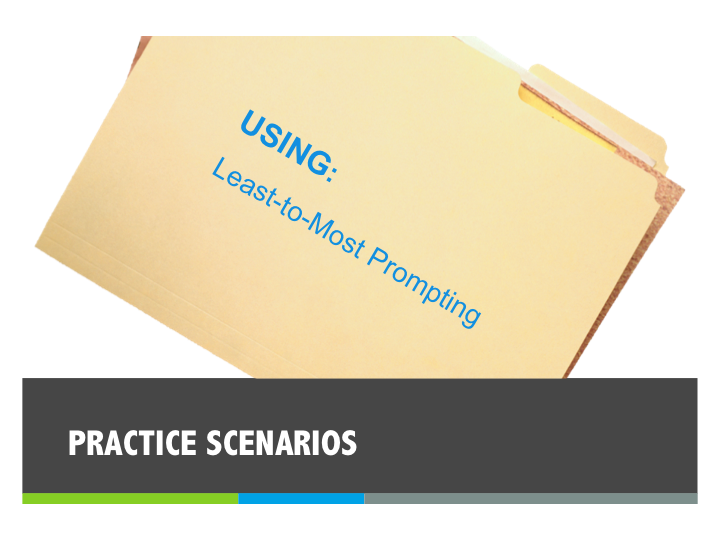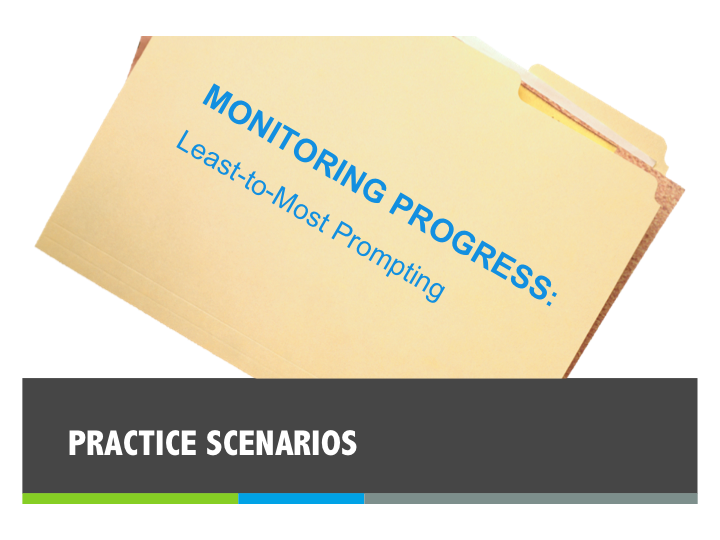Least-to-Most Prompting
This prompting procedure is also referred to as the system of least prompts. With this procedure, a prompt hierarchy is used to teach toddlers with ASD new skills.
Levels of Least-to-Most Prompting Hierarchy
- The first level provides the toddler with the opportunity to respond without prompts.
- The remaining levels are sequenced from the least amount to the most amount of help.
- The final prompt is a controlling prompt that ensures that the toddler will complete the behavior or skill.
Least-to-Most Prompting is one of two prompting procedures included in this module. A variety of prompting procedures support the learning and development of toddlers with ASD.
Review information on both prompting procedures covered in this learning module and information on determining which prompting procedure is the most appropriate for an individual toddler and the type of target skills or behaviors you wish to teach.
Step 1 Planning
![]()

Step 1 for implementation of Least-to-Most Prompting involves planning the intervention. In this section, you will review steps for selecting a target behavior, identifying learning opportunities, choosing the cue or task direction for prompting, sequencing and fading prompts, and planning for data collection.
Step 1.1 Select the target behavior or skill
Select and describe the target behavior or target skill.
Beginning with the IFSP, the EI team discusses with the parent the strengths and challenges of the toddler in meeting a priority outcome and then describes the target skill. The IFSP outcome should be observable and measurable in order to be able to clearly describe the expected skill that the toddler will learn and how to determine when the toddler has mastered the skill.
EXAMPLE
Parents discuss with the providers that their toddler, Charlie, has few if any means of communicating his wants and needs. He uses unconventional ways to communicate what he wants such as going to the kitchen, standing in front of the refrigerator, and crying.The IFSP team initially writes the outcome in the following manner:
"Charlie will communicate his wants and needs by using another form of communication instead of crying."
Consider: Is the selected target skill or behavior described in observable and measurable terms?
The IFSP team initially had written Charlie's outcome in the following manner.
Initial outcome:

While this outcome describes the hopes and wishes of the parents, it is not written in an observable and measurable way.
The target skill is described as “communicate” by “not crying”. The activities and routines are not specified. This IFSP outcome can be re-written so that it is observable and measurable. To do this, the team will need to clearly describe the context (WHEN), the target skill the toddler will perform (WHAT) and how will we know Charlie has mastered this skill (HOW).
Re-written outcome:

The new outcome describes routines or activities with target skills that are observable and can be measured.
Step 1.1a Discrete or chained skill?
The next step is to determine if the target skill or behavior is a discrete or chained skill.
A discrete task or skill is a discrete task requires a single response. Discrete skills could be pointing to objects, naming objects, holding out a hand, or a task of putting objects in a container.
EXAMPLES OF DISCRETE TASKS
- pointing to or reaching for an object to request
- requesting an object verbally using the first sound in the word for the object
- pushing a truck on a “road” to a toy garage.
A chained task requires a number of individual behaviors which are chained or sequenced together to form a more complex skill.
EXAMPLES OF CHAINED TASKS
- washing hands
- brushing hair
- completing a sequence of a play scheme
Step 1.1b Decide on the number and sequence of steps
Decide on the number and sequence of steps in a chained task.
If the target behavior is a chained task or skill, decide on the number and sequence of steps in the chain.
You can decide on the number and sequence of steps in a chain in the following ways:
- Observe a typical toddler performing the chain. Write down the steps.
- Ask the parent to help their toddler perform the chain. Write down the steps.
- Perform the chain yourself. Write down the steps.
Use the steps you have identified as the sequence of steps in the chained task to teach the toddler.
EXAMPLE
A chained task for washing hands would include the following steps:
- Toddler climbs step stool to reach sink.
- Toddler opens hands over the sink so adult can pump soap onto hands
- Toddler rubs hands together.
- Adult turns on water and toddler puts hands under running water.
- Toddler gets paper towel.
- Toddler wipes hands on paper towel.
- Toddler throws away paper towel.
 Video: Chained Task - Washing Hands
Video: Chained Task - Washing Hands
After each step in the chain has been described, decide:
Will you teach one step at a time?
Will you teach all the steps at the same time?
Step 1.2 Identify learning opportunities
Identify learning opportunities that will be the activities and routines to use with the toddler.
Select the activities and routines within which to teach the target skill. These activities and routines should be the learning opportunities that are naturally built into a toddler’s day.
- Using a toddler’s favorite activities will increase motivation through the use of natural reinforcers for the toddler.
- Using typical routines will allow the toddler to practice the target skills or behaviors frequently throughout the day.
Step 1.3 Identify the target stimulus
The target stimulus is the event or situation that cues the toddler to engage in the target behavior or target skill.
Target stimulus
Naturally occurring event
- If the target behavior is washing hands, then the target stimulus is having dirty hands or telling the toddler, “It is time for snack.”
- If the target behavior is waving "bye-bye," then the target stimulus would be a parent waving "bye-bye" to leave for work.
Completion of one event or activity
- If the target behavior is cleaning up after snack or a meal, then the target stimulus is completing the snack or meal.
External signal
- If the target behavior is coming to the table for a snack, then the target stimulus is opening the refrigerator.
- If the target behavior is getting ready to take a bath, then the target stimulus is turning on the faucet and running the water in the tub.
Step 1.4 Choose the cue or task direction
A cue or task direction is the “bridge” used to help the toddler identify the target stimulus and then engage in the target skill or behavior.
Choosing a Cue or Task Direction
The following types of cues may be selected depending on the skills of the individual toddler:
MATERIAL OR ENVIRONMENTAL MANIPULATION
Material or environmental manipulation can be used as cues or task direction by setting up the materials before the toddler comes to the activity. An example of environmental manipulation is when a EI provider or parent might place a toy on the rug prior to a play routine. Another example could be placing a small amount of a desired food on a plate in front of the toddler while placing a closed container with more of the desired food further away from the toddler.
TASK DIRECTION
A task direction is when you tell the toddler specific or giving the toddler a visual cue. For example, the EI provider or parent might say “All gone” or sign “All done” and then point to an empty bowl.
NATURALLY OCCURING EVENT
An example of a naturally occuring event is when a toddler sees a parent opening the cabinet to get food for snack, and then opening the refrigerator to get juice. Another example would be the parent turning on the faucet to fill up the bathtub.
EXAMPLE
A parent wants their toddler to ask for more cereal at breakfast table.
- The target stimulus is no more cereal in the toddler's bowl.
- The cue is saying, “All gone”
IIdentifying the Activity, Target Stimulus, Cue or Task Direction |
|||
|---|---|---|---|
|
Discrete skill: "Use one word utterance to request 3 favorite objects or food" |
|||
Word used: |
Activity (or Routine) |
Target Stimulus |
Cue or Task Direction |
|
“Truck” |
Play on floor |
Preferred toy out of reach (truck) |
“Let’s play.” |
|
“Boat” |
Bath Time |
Preferred toy out of reach (boat) |
“Time to play in tub.” |
|
“Apple” |
Snack |
Favorite snack out of reach (apple) |
“Snack all gone” |
Chained task as an activity: Washing hands prior to meals |
|
|---|---|
|
Target Stimulus: “First wash hands, then eat.” |
|
Chained Task Target Skill |
Cue or Task Direction |
|
Climbs steps of step stool |
Adult walks to the sink and says “Time to wash hands” |
|
Turns palms up |
Adult picks up soap dispenser, shows toddler and says, “Get soap” |
|
Rubs hands together |
Adult puts down soap dispenser and says “Rub hands” |
|
Puts hands under running water |
Adult turns on faucet and says “Rinse hands” |
|
Gets towel and rubs hands on towel to dry |
Adult turns off faucet and says “Dry hands” |
|
Throws towel in trash can |
Adult says “Put in trash” or “All Done” |
Step 1.5 Select reinforcers
Select reinforcers to pair with the target skill or behavior.
- highly motivating,
- naturally reinforcing, and
- tied to the activity or routine within which the target skill or behavior will be used by the toddler.
The goal of reinforcement is to increase the likelihood that the toddler will use the target skill again in the future. Positive reinforcement is generally the strategy that adults use first when trying to teach new skills or behaviors. Positive reinforcement refers to the presentation of a reinforcer after a toddler uses a target skill or behavior, therefore encouraging him/her to perform that behavior again in the future.
The toddler's deprivation state is when the toddler cannot have, or is deprived of, what he or she wants.
Positive reinforcers can be either primary or secondary.
Primary Reinforcers
Primary reinforcers are often naturally reinforcing to toddlers with ASD. These might include verbal praise, highly preferred activities, stickers, toys, or edibles.
Secondary Reinforcers
The value of secondary reinforcers must be learned by pairing primary reinforcers with other types of reinforcement. An example of a secondary reinforcer might be pairing the primary reinforcer using verbal praise, “You did it!” with a chance to play with a favorite toy.
Positive reinforcers include:
- access to a desired or preferred activity/favorite toy (e.g., special job, squishy ball, playing with cars, sand table) or social game (such as peek-a-boo or “so big”).
- specific verbal praise (e.g. “You put the block in!”).
- hugs or physical activity.
- access to the preferred food or drink
When choosing reinforcers, answer the following questions:
-
What has motivated the toddler in the past?
-
What does the toddler want that he/she can't easily get? This is called the toddler's deprivation state.
-
What reinforcer is appropriate for the target skill and routine or activity?
EXAMPLE
A toddler with ASD may continually request crackers that are placed in a cupboard or on a high shelf, however, the EI provider or parent only gives the toddler the crackers once a day.
Because the toddler wants the crackers, but cannot easily get them, this is considered his deprivation state.
The chosen reinforcer should be as natural as possible and it should be related to the activity that is going on. It would be natural for a toddler with ASD to have access to a preferred or desired activity/object after taking part in a challenging, non-preferred activity.
EXAMPLE
If the toddler does not enjoy washing his/her face, then a possible positive reinforcer to receive after completing the routine would be to select a highly desirable toy to give to the toddler once the activity is complete. Another example would be to use food as a reinforcer during routines such as snack or meal times when the target skill is requesting.
For more information on reinforcers, refer to ASD Toddler Initiative module on Reinforcement.
Step 1.6 Select the number of prompt levels
Select the number of prompt levels of the least-to-most hierarchy.
The number of levels of the least-to-most hierarchy depends on:
- the characteristics of the activity,
- the skill being taught, and
- the characteristics of the toddler.
A minimum of three levels is required. Prompts are individually determined, with a maximum of 3 levels. For example, pointing to the target stimulus (gestural prompt) and next modeling an action (model prompt).
There is no limit to how many levels can be used, but generally no more than five levels is practical.
Prompt Level |
Prompt |
Characteristics of the Level |
|---|---|---|
First |
Indpendent |
No prompts Target stimulus and cue are presented |
Intermediate |
Increasing help given and less help than the last level | Prompts are individually determined, with a maximum of 3 levels |
Most |
Controlling prompt | Prompt used is selected to ensure that the toddler will respond and perform the skill or behavior correctly |
 Video: Prompting Hierarchy
Video: Prompting Hierarchy
![]() Tips on Determining the Number of Prompt Levels
Tips on Determining the Number of Prompt Levels
CHARACTERISTICS OF THE LEARNING TASK OR ACTIVITY
With easy target skills, fewer levels are recommended. With more difficult skills, more levels may be necessary.
CHARACTERISTICS OF THE TODDLER
The more prompting levels in the hierarchy, the longer the toddler will have to wait to be successful. If the toddler with ASD has difficulty staying engaged in the activity or routine for a long period of time, then less prompting levels will increase attention and reduce the likelihood of disruptive or problem behaviors (e.g. crying, stereotypical or repetitive behaviors). If it is determined that the toddler needs more assistance to complete a target skill successfully, then more levels would be appropriate.
TIME AVAILABLE FOR USING PROMPTING IN THE ACTIVITY OR ROUTINE
In general, the more levels that are included in a prompting hierarchy, the longer the activity and fewer opportunities for working on the target skill.
Review prompt dependence in the EBP Overview.
Step 1.7 Select the type of prompts to be used at each level
Any number of prompts can be used in the hierarchy. EI providers and parents should consider individual characteristics when selecting prompts. For example, if the toddler does not like being touched or seeks touch, then a full physical prompt might not be a good choice. If a toddler can easily imitate, then model prompts might be appropriate; but if the toddler cannot imitate, then model prompts would not be the best choice.
Some common mistakes include:
- Using frequent verbal prompts.
- Too frequent use of physical prompts when less intense and intrusive prompts may be effective.
- Using prompts that are not appropriate for the individual toddler
Using a visual prompt of a lined drawing of an object when the toddler does not understand visual representation
 Helpful Questions
Helpful Questions
-
Which types of prompts have been successful in teaching the toddler new skills?
-
Has the toddler been taught how to use this type of target skill before?
-
What types of prompts have been the most successful when teaching the toddler a variety of skills?
-
If this target skill has been successfully taught to others toddlers, what was the least-to-most sequence?
- Does the toddler use the target skill correctly when each prompt is used separately?
 View the chart on types of prompts in the EBP Overview section of this module.
View the chart on types of prompts in the EBP Overview section of this module.Step 1.8 Sequence the prompts from least-to-most
When sequencing, determine which prompts provides the toddler with:
- the least amount of assistance,
- more information, and
- the most amount of assistance or enough to perform the skill or behavior correctly.
Sequence prompts from least-to-most, beginning with the independent level (least) and progressing to increased assistance (most) within the hierarchy.
You may want to ask the following questions:
a) Which types of prompts have been successful in teaching the toddler new skills?
b) Has the toddler been taught how to use this type of target skill before?
c) What types of prompts have been the most successful when teaching the toddler a variety of skills?
d) If this target skill has been successfully taught to others toddlers, what was the least-to-most sequence?
e) Does the toddler use the target skill correctly when each prompt is used separately?
(Wolery, Ault, & Doyle, 1992)
Step 1.9 Decide when to give the cue
The cue (or task direction) can be given:
- at the first prompt level.
- at each step of the prompt hierarchy. This is most appropriate when a toddler is first learning the skill.
Review two examples of prompt hierarchy with a given target stiumulus.
Example 1
Prompt Level |
Prompt |
Characteristics of the Level |
|---|---|---|
First |
Indpendent |
No prompts |
Intermediate |
First prompt Second prompt |
Gestural prompt: The adult holds up juice pitcher, shrugs shoulders, and raises eyebrows as if to say, “What do you want?” Verbal prompt: The adult says, “What do you want?” |
Most |
Model prompt | Model prompt: The adult says, “Juice.” Taylor says, “Juice.” Adult pours Taylor more juice. |
Example 2
Prompt Level |
Prompt |
Characteristics of the Level |
|---|---|---|
First |
Indpendent |
No prompts The adult says, "Wipe mouth." |
Intermediate |
First prompt Second prompt |
Gestural prompt: The adult points to the napkin on the table. Model prompt: The adult holds up the napkin and models wiping their mouth. |
Most |
Last prompt | Partial physical prompt: The adult moves the toddler's hand to the napkin and assists with bringing the napkin to his mouth. |
Step 1.10 Select the response interval
A response interval is the length of time to wait for the toddler to perform the skill or behavior before prompting the toddler to use the target skill. You should base the response interval on the individual characteristics of the toddler.
Generally a response interval is between 3 to 5 seconds.
The response interval is important because it builds in a short pause, allowing the toddler to process the cue and respond on their own to the specific prompt prior to the adult giving the toddler another prompt in the hierarchy. You will use this response interval at each prompting level.
Answering the following questions will help determine the length of the response interval for the toddler:
- How long does it take the toddler to complete a similar skill?
- How long does it usually take the toddler to respond when he/she knows how to do the skill? Add a couple of seconds to the usual response time.
- How long does it take another toddler with ASD to use a similar skill?
- What amount of time will the toddler be allowed to begin and complete an activity or routine? This would be important for a chained task or skill such as getting dressed, undressed, washing hands, etc. Some skills in the chain make take longer than the others. In that case, use the longest interval as the response interval.
Step 1.12 Plan a data collection strategy
You should develop your data collection strategy and decide on data collection forms to use prior to implementing least-to-most prompting.
At a minimum, data collected should include collecting information on the following:
unprompted correct responses
Correct response at the independent level of the hierarchy. This is the goal; thus, these responses should be reinforced and counted.
prompted correct responses
Any correct response that occurs after any of the prompt levels of the hierarchy. These responses should be reinforced and counted.
incorrect responses
These can be either unprompted errors - incorrect responses made at the independent level of the hierarchy (before any prompts are delivered), or prompted errors - incorrect responses made after any of the prompt levels of the hierarchy. For any incorrect response, you will be using a correction procedure.
no responses
Toddler does not make any response after the delivery of the last level in the hierarchy.
Step 1.13 Gather baseline data
Gather and record baseline data on the target skill(s). Information should be collected prior to beginning to use least to most prompting on the toddler’s ability to perform the target skill(s) (e.g. the baseline performance data).
A planning worksheet for prompting is available and included in the Module Resources section.
Practice Scenario: Planning Least-to-Most Prompting
The practice scenario will open as a PDF file  in a new browser tab/window.
in a new browser tab/window.
When you have finished reviewing,
return to the module and take the Knowledge Check.
test prompting video for scenario
Knowledge Check

Question:
Consider the following target skill: Josh will complete a four piece wooden puzzle.
-
Is this a discrete or chained task?
-
Identify the target stimulus and cue.
-
How might you write the target skill so that the description is measurable and observable?
Question:
What are the three levels in a prompt heirarchy? Briefly describe each.
Question:
How do you determine the response interval?
Step 2 Implementing Least-to-Most Prompting
Using this prompting procedure requires following the steps outlined in the prompt hierarchy that was planned.
Step 2.1 Deliver the target stimulus and the cue
Present the target stimulus and the cue (or task direction).
- First get the toddler's attention.
- Then present the target stimulus and the cue.
EXAMPLE
Charlie is learning how to complete a clean-up routine. Charlie’s mom would first move close to Charlie and either stand in front of him at eye level or touching his arm. Then she would focus his attention to "all finished with eating." Charlie's mom would then hand Charlie the place and say, "Time to clean-up."
Charlie's mom secured Charlie's attention by standing in front of him at eye level or touching his arm.
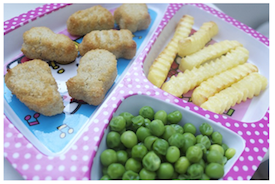
Target stimulus: Charlie is all finished with eating.
Cue: Charlie's mom hands Charlie the plate and says, “time to clean-up.”
Step 2.2 Using the response interval, wait for the toddler to respond

Wait the number of seconds specified in the response interval. This is the time between delivering the cue and the prompt.
Parents can participate even in the early stages of using the prompting procedure by counting the number of seconds after the cue and then by signaling the EI provider to prompt if the toddler has not responded.
Step 2.3 Deliver prompts following the toddler's attempts
If the toddler's response is incorrect, provide positive feedback and the reinforcer to the toddler. This can be accomplished by interrupting the incorrect response, and then deliveriving the next prompt in the hierarchy. Also, deliver the controlling prompt last if toddler does not respond to the other levels of the hierarchy.
Use the response interval prior to delivering another prompt in the hierarchy.
Step 2.4 Fade prompts in the least-to-most hierarchy
As the toddler learns the target skill or behavior, you will need to implement the plan to fade prompts.
Review how to fade prompts in Step 1.11.
Tips for Effective Least-to-Most Prompting
When delivering prompts:
-
Prompts should be as weak as possible.
-
Unplanned prompts should be avoided.
-
Prompts should be faded as quickly as possible.
When fading prompts:
-
Use fewer levels of prompts. If a higher level of prompting is used, toddler may appear to be learning but may be dependent on the prompt not the cue.
-
Fading should be determined by monitoring toddler’s unprompted and prompted correct responses
-
Fade prompts and/or increase the response interval or wait time gradually and systematically.
-
Fade prompts as quickly as it is determined that toddler is responding without the prompts.
-
If prompts are not faded, prompt dependency can develop. Prompt dependency occurs as result of using prompts when not needed.
Practice Scenario: Using Least-to-Most Prompting
The practice scenario will open in a new browser tab/window.
When you have finished reviewing,
return to the module and take the Knowledge Check.
Knowledge Check

Question:
What should you do after getting the toddler’s attention and providing the target stimulus and cue?
Question:
What strategies should you use if the toddler responds incorrectly to a prompt?
Question:
Describe some prompt fading strategies.
Step 3 Monitoring Progress
![]()

To monitor the effectiveness of least-to most-prompting, it is important to gather data and evaluate what types of responses are being made by the toddler.
Step 3.1 Schedule and record data
Schedule and record data on each type of response. Select a schedule for collecting and reviewing data for on-going monitoring. A schedule for collecting and reviewing the data should specify how frequently you will monitor (e.g. at each home visit, during each routine or activity on a daily basis).
Decide whether to record each trial during the activity or routine or to only record the last trial in the activity or routine.
Record each type of response that occurs. A suggested response coding scheme is provided in the images below.
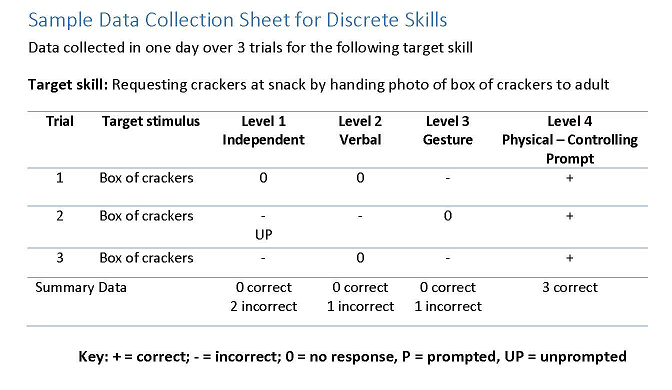

Download the Sample Data Collection Sheet from the Module Resources section.
Step 3.1a Record data on four types of potential responses
Toddler responses to the prompts in using the target skills are not always successful. Therefore, the responses of the toddler can be thought of as correct (+) or incorrect (-), either with prompting or without prompting.
If the toddler completes the expected steps of washing hands without prompts, all responses would be coded as unprompted correct (+).
EI providers should track all of these responses because their occurrence provides valuable information about the toddler’s performance and progress. The data sheet should reflect each trial.
Review more about the four types of potential responses:
Step 3.2 Analyze the data
Analyze the data to determine if progress is being made.
Determine whether the unprompted and prompted correct responses total 100% of the toddler’s performance.
First, calculate the percentage of the unprompted correct, the percentage of the prompted correct, and the percentage of the incorrect responses. This should equal 100%.
Determine if the percentage of unprompted correct responses are increasing over time.
Next, review the data, based on your schedule of monitoring, to determine if the percentage of unprompted correct responses is increasing over time. If your target skill/behavior is a chained task, you will need to analyze each step of the chain.
Step 3.3 Use information from data
Use the data to modify, revise, or change the use of least-to-most prompting to enhance acquisition of the target skill or behavior.
Analysis of the data can help pinpoint problems in implementing the prompting procedure correctly or guide decisions about when the prompting procedure needs to be changed. Revisions or modifications to prompting might include:
- changing the type of controlling prompt needed,
- reducing the number of prompts within the hierarchy,
- changing the cue or response interval, and
- when to begin fading the prompts.
Based on the data and using the strategies on how to fade prompts that were discussed in the Step 1.11, remember to fade prompts in the hierarchy.
Common Problems and Solutions When Using Prompting
Problem |
Solution |
|
The toddler consistently makes errors at the final level in the hierarchy. |
Select a new, more controlling prompt |
|
The toddler consistently makes errors at an intermediate level. |
|
|
The toddler consistently waits for a prompt instead of attempting to respond at the independent level. |
Differentially reinforce prompted and unprompted correct responses or eliminate reinforcement for prompted correct responses |
|
The toddler consistently fails to respond at any level, including the final level. |
Find a more powerful reinforcer. |
EXAMPLE
The EI provider continues to monitor progress of the toddler asking for crackers. She reviews data collected over a period of one week.

The data in the chart reflects that the controlling prompt has shifted from physical to gestural, given that the toddler is responding correctly at that intermediate prompting level.
A decision would be made to reduce the number of levels in the prompt, now only 3 levels.
Practice Scenario: Monitoring Least-to-Most Prompting
The practice scenario will open in a new browser tab/window.
When you have finished reviewing,
return to the module and take the Knowledge Check.
Knowledge Check
Question:
What are the types of responses that should be collected when monitoring progress?
Question:
What can the data collected tell you about the effectiveness of the least-to-most prompting procedure?
Question:
What are some common mistakes that can occur when using least-to-most-prompting?
